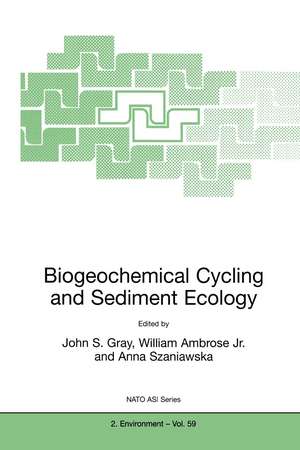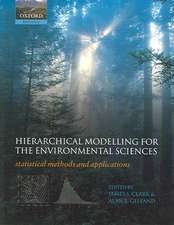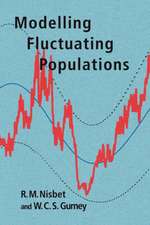Biogeochemical Cycling and Sediment Ecology: NATO Science Partnership Subseries: 2, cartea 59
Editat de J. Gray, William Ambrose Jr., Anna Szaniawskaen Limba Engleză Paperback – 23 oct 2012
| Toate formatele și edițiile | Preț | Express |
|---|---|---|
| Paperback (1) | 942.44 lei 6-8 săpt. | |
| SPRINGER NETHERLANDS – 23 oct 2012 | 942.44 lei 6-8 săpt. | |
| Hardback (1) | 947.18 lei 6-8 săpt. | |
| SPRINGER NETHERLANDS – 31 mai 1999 | 947.18 lei 6-8 săpt. |
Din seria NATO Science Partnership Subseries: 2
- 15%
 Preț: 638.43 lei
Preț: 638.43 lei - 5%
 Preț: 1420.29 lei
Preț: 1420.29 lei -
 Preț: 390.84 lei
Preț: 390.84 lei - 18%
 Preț: 949.90 lei
Preț: 949.90 lei -
 Preț: 401.24 lei
Preț: 401.24 lei - 15%
 Preț: 653.14 lei
Preț: 653.14 lei - 5%
 Preț: 1414.64 lei
Preț: 1414.64 lei - 15%
 Preț: 642.18 lei
Preț: 642.18 lei - 18%
 Preț: 1846.40 lei
Preț: 1846.40 lei - 18%
 Preț: 949.90 lei
Preț: 949.90 lei -
 Preț: 380.07 lei
Preț: 380.07 lei - 15%
 Preț: 643.84 lei
Preț: 643.84 lei - 18%
 Preț: 1839.63 lei
Preț: 1839.63 lei -
 Preț: 416.64 lei
Preț: 416.64 lei - 18%
 Preț: 1234.77 lei
Preț: 1234.77 lei - 18%
 Preț: 1834.90 lei
Preț: 1834.90 lei - 18%
 Preț: 950.96 lei
Preț: 950.96 lei - 15%
 Preț: 655.78 lei
Preț: 655.78 lei -
 Preț: 403.53 lei
Preț: 403.53 lei -
 Preț: 381.98 lei
Preț: 381.98 lei - 18%
 Preț: 1836.94 lei
Preț: 1836.94 lei - 15%
 Preț: 645.47 lei
Preț: 645.47 lei - 18%
 Preț: 946.87 lei
Preț: 946.87 lei - 18%
 Preț: 1227.99 lei
Preț: 1227.99 lei - 18%
 Preț: 1232.57 lei
Preț: 1232.57 lei -
 Preț: 398.15 lei
Preț: 398.15 lei - 18%
 Preț: 1232.71 lei
Preț: 1232.71 lei - 18%
 Preț: 1223.88 lei
Preț: 1223.88 lei - 18%
 Preț: 1228.77 lei
Preț: 1228.77 lei
Preț: 942.44 lei
Preț vechi: 1149.32 lei
-18% Nou
Puncte Express: 1414
Preț estimativ în valută:
180.35€ • 189.64$ • 149.01£
180.35€ • 189.64$ • 149.01£
Carte tipărită la comandă
Livrare economică 16-30 aprilie
Preluare comenzi: 021 569.72.76
Specificații
ISBN-13: 9789401059626
ISBN-10: 9401059624
Pagini: 252
Ilustrații: XII, 236 p.
Dimensiuni: 160 x 240 x 13 mm
Greutate: 0.36 kg
Ediția:Softcover reprint of the original 1st ed. 1999
Editura: SPRINGER NETHERLANDS
Colecția Springer
Seria NATO Science Partnership Subseries: 2
Locul publicării:Dordrecht, Netherlands
ISBN-10: 9401059624
Pagini: 252
Ilustrații: XII, 236 p.
Dimensiuni: 160 x 240 x 13 mm
Greutate: 0.36 kg
Ediția:Softcover reprint of the original 1st ed. 1999
Editura: SPRINGER NETHERLANDS
Colecția Springer
Seria NATO Science Partnership Subseries: 2
Locul publicării:Dordrecht, Netherlands
Public țintă
ResearchCuprins
Geochemistry of Organic Carbon in the Ocean.- Primary Production and Decomposition of Organic Matter in Coastal Areas of the Northern Aral Sea, with Special Reference to Land-Sea interactions.- Biogeochemistry of Water and Sediment in the OB and Yenisey Estuaries.- The Continental-Ocean Boundary as a Marginal Filter in the World Oceans.- Unjustifiably Ignored: Reflections on the Role of Benthos in Marine Ecosystems.- Understanding Small-Scale Processes Controlling the Bioavailability of Organic Contaminants to Deposit-Feeding Benthos.- The Role of the Marine Gastropod Cerithium Vulgatum in the Biogeochemical Cycling of Metals.- Changes in Macrozoobenthos Communities Induced by Anthropogenic Eutrophication of the Gulf of Gdansk.- Do Benthic Animals Control the Particle Exchange between Bioturbated Sediments and Benthic Turbidity Zones?.- Impact of Catchment Land-Use on an Estuarine Benthic Food Web.- Natural Variability and the Effects of Fisheries in the North Sea: towards an Integrated Fisheries and Ecosystem Management?.- Community Composition of Tidal Flats on Spitsbergen: Consequence of Disturbance?.- The Problem of Scale: Uncertainties and Implications for Soft-Bottom Marine Communities and the Assessment of Human Impacts.- Understanding the Sea Floor Landscape in Relation to Impact Assessment and Environmental Management in Coastal Marine Sediments.- Conclusions and Recommendations.




















